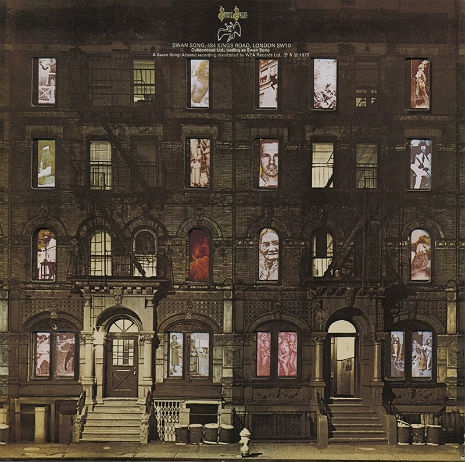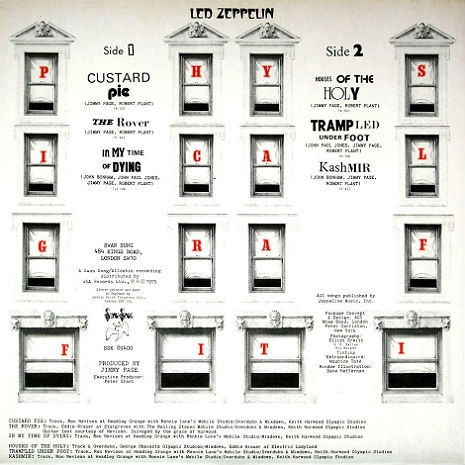
With just a few days to go before the release of the newly remastered and expanded “super-deluxe” version of Led Zeppelin’s Physical Graffiti album—my personal favorite, although I’m also partial to III—I thought it would be a good time to post about its iconic cover art. Physical Graffiti was originally released on February 25, 1975. I was nine then, and already a budding rock snob and Led Zeppelin fanatic after buying their first four albums at a neighbor’s garage sale for a quarter each (Score!). I can remember seeing Physical Graffiti when it first turned up in record stores—it was a very solid package, heavy in the hand and also mysterious looking, like some sort of mass-produced, cellophane-wrapped occult object d’art. I coveted that album but it was too expensive for me to buy at that age. I think I ended up getting it as like an Easter present or something. In any case, I recall it being a real event in my young life to get to finally own that epic thing and I listened to it so many times before I even reached my teens that it became a part of my DNA. It’s the ultimate Led Zeppelin tour de force.
The outer cover art is a heavily doctored photograph of two side-by-side five-story tenement buildings discovered by designer Peter Corriston located at #96 and #98 St. Mark’s Place in New York’s East Village, near Tompkins Square Park. The fourth floors were cropped out entirely to better form a square album cover, and the windows were cut out holes, something similar to what the group had already done with the spinning wheel cover of III.

The front cover is a daytime shot, while the back cover was taken at night. Amongst the tenants who can be seen through the die-cut windows are JFK assassin Lee Harvey Oswald, astronaut Neil Armstrong, Elizabeth Taylor as Cleopatra, King Kong, the Virgin Mary, Judy Garland and the main cast of The Wizard of Oz, members of Led Zeppelin in drag, their infamous manager Peter Grant, body builder Charles Atlas, the Queen and Laurel & Hardy. The inner sleeve could be combined in a number of ways to make different covers, and there was an inner sleeve designed by Mike Doud with all the song titles that saw the title written out on closed window shades:

For several years in the 1980s, I lived on this very block, and then right around the corner. I’ve walked past this site a gazillion times. Even in a pre-Internet era, I’m pretty sure that most people who lived on that block knew that they lived near the Physical Graffiti cover. Or even lived in it. Eventually a second-hand clothing store called Physical Graffiti opened up in the basement making it glaringly obvious to any tourist with half a clue and willing to look up. It’s the faces (sconces) that are ultimately the dead giveaway. Now there’s probably an app for finding it. Next time you’re in NYC, you can take a selfie or something cute for your Instagram account in front of the Physical Graffitea shop (and then, as the tee-shirt says, you can “go the fuck home.”)
The Google Street View of St. Marks Place between First Avenue and Avenue A:
One of the buildings on the Physical Graffiti album cover are the same stoops where Mick is seen cooling his heels before Keef boogies along and collects him in the Rolling Stones’ “Waiting on a Friend” music video (also shot in the perennially divvy shithole, the St. Marks Bar and Grill on the corner.)
Simon Gardiner recreated the Physical Graffiti cover as the buildings look today. If you click through to his Flickr page, you can see a sharply detailed larger version.

Gardiner also dug up this choice morsel of Led Zeppelin-related arcana…
Unlikely as it may seem, the concept was itself heavily influenced by the design for Jose Feliciano’s album, Compartments (1973).

Entirely plausible. Led Zeppelin were apparently never shy about borrowing…
Below, one of the album’s highlights, “In My Time of Dying” performed live at Earl’s Court, London, 1975